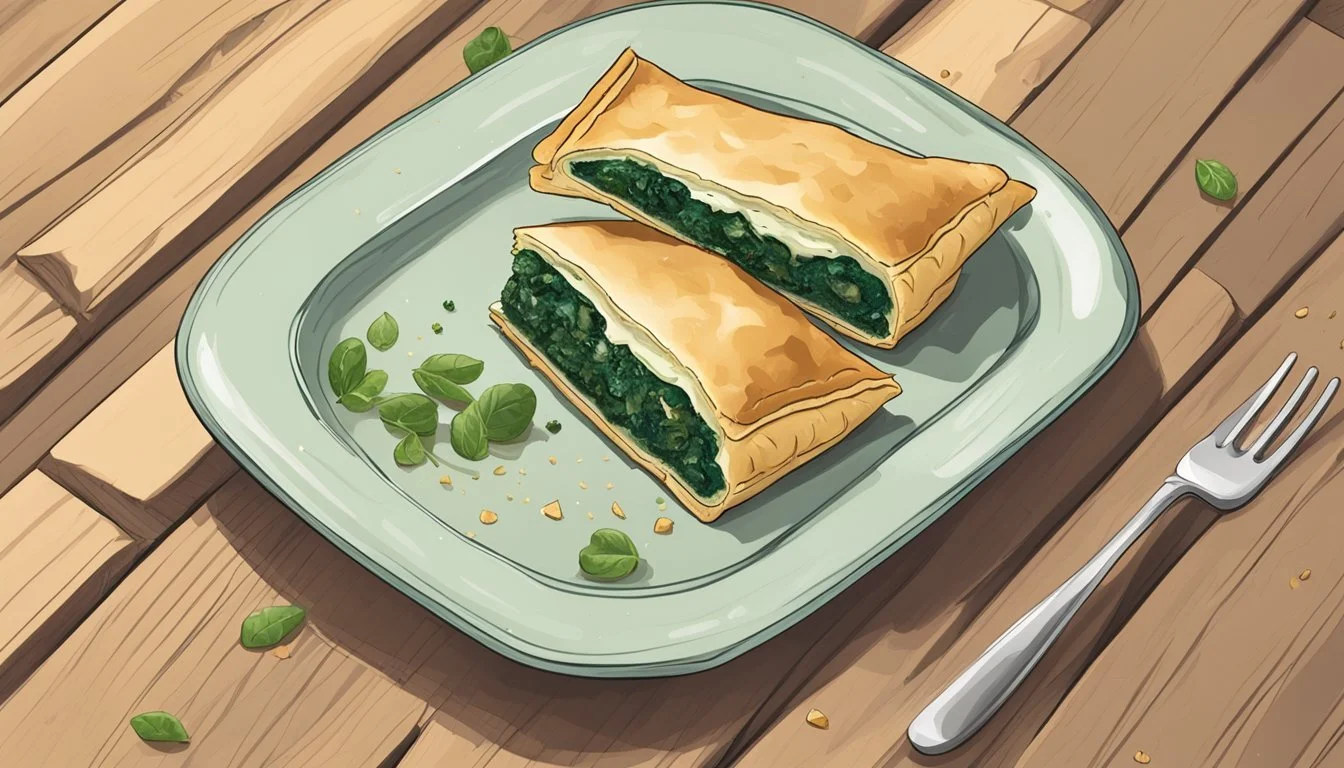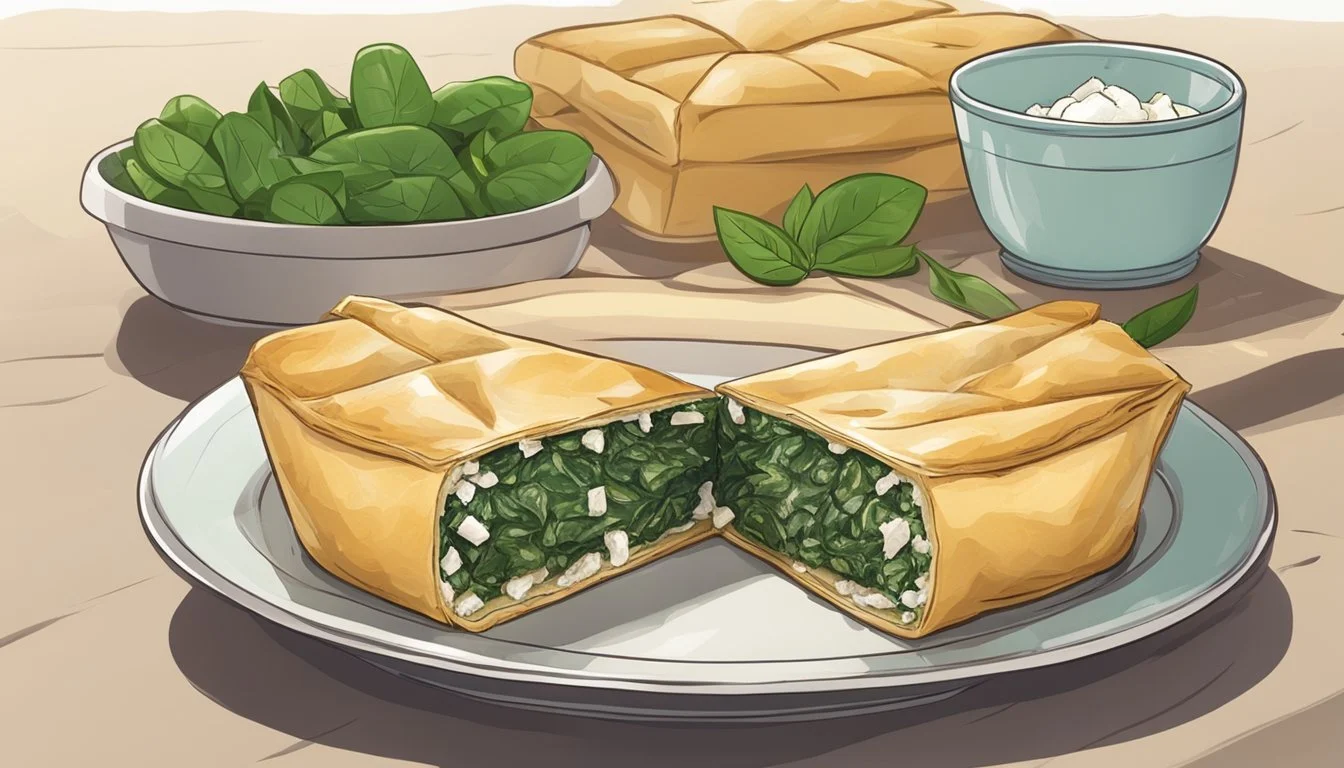How Long Does Gluten-Free Spanakopita Last?
Tips for Freshness and Storage
Spanakopita, a classic Greek pastry, often nestled in flaky layers, is a savory delight filled with spinach and feta cheese. When made gluten-free, it maintains its delicious appeal while catering to those with dietary restrictions. Gluten-free spanakopita typically lasts about 3 to 4 days if stored properly in the refrigerator.
Ensuring freshness involves allowing the pastry to cool completely before transferring it to an airtight container. This prevents moisture build-up, which can compromise the texture of your spanakopita. For longer storage, spanakopita can be frozen and enjoyed later.
Whether using a pre-made gluten-free puff pastry or crafting your own dough, proper storage is key to maintaining that indulgent flavor and texture. By following these guidelines, you can savor your gluten-free spanakopita well beyond its baking day.
Understanding Spanakopita
Spanakopita, a beloved Greek dish, emphasizes the harmonious blend of spinach, feta cheese, and various aromatic herbs. This section explores its origins, traditional ingredients, and the adaptations for creating a gluten-free version.
Origins and Cultural Significance
Spanakopita, a traditional Greek dish, has roots deeply embedded in Greece’s rich culinary history. Often enjoyed as a snack or part of a larger meal, spanakopita translates directly to "spinach pie." It is a common staple in Greek households and widely celebrated during festivals and gatherings.
The dish’s legacy lies in the use of local, fresh ingredients, reflecting Greece's agricultural tradition. The precise origin date is unclear, but it is believed that its recipes have been passed down through generations. Spanakopita showcases the adaptability and ingenuity of Greek cuisine.
Traditional Ingredients
Traditional spanakopita consists of spinach, which is the main ingredient, combined with salty feta cheese. The mix usually includes onions or shallots, leeks, and often, aromatic herbs like dill. Eggs are integral, acting as binders to hold the filling together.
Olive oil, butter, salt, and pepper season the mixture, enhancing the flavors. The filling is enveloped in thin layers of phyllo dough, which becomes crispy and golden when baked. Proper layering is key to achieving the desirable, flaky texture characteristic of well-crafted spanakopita.
Gluten-Free Adaptations
To make spanakopita suitable for a gluten-free diet, traditional phyllo dough can be substituted with gluten-free phyllo dough or a gluten-free flour blend. The filling’s core ingredients remain the same: spinach, feta cheese, and aromatic herbs.
Gluten-free rough puff pastry can also be an alternative, although handling and texture might slightly differ from traditional dough. Careful attention is paid to maintaining the flaky, crispy layers by rolling the dough thinly and ensuring multiple folds.
Adjustments in baking times might be necessary, but the core flavors and textures aim to stay true to the original dish. This adaptation allows those with gluten sensitivities to enjoy this quintessential Greek pie.
Preparation Guidelines
To create a delicious gluten-free spanakopita, follow these preparation steps. These include making the gluten-free pastry, assembling the filling, and baking the pastry to perfection.
Creating the Gluten-Free Pastry
Start with making a gluten-free pastry dough. Some prefer a rough puff pastry style for its flakiness. Mix gluten-free flour, cold butter cubes, a pinch of salt, and ice water to form the dough.
Use a pastry scraper to combine the ingredients until the dough is smooth. Roll out the dough on a floured surface into thin sheets. If making phyllo dough, ensure it's paper-thin. For additional layers, brush with melted butter or olive oil.
Assembling the Spanakopita
Create the filling with fresh spinach, feta, and ricotta cheese. Sauté spinach in olive oil until wilted. Combine cooled spinach with cheeses, beaten egg, and season with salt, pepper, and nutmeg.
Lay a sheet of gluten-free pastry on a parchment paper-lined baking tray. Spoon the filling down the center. Fold or layer additional pastry sheets on top, brushing each layer with butter. Cut the layered pastry into individual pieces before baking.
Baking Techniques
Preheat the oven to 375°F (190°C). Place the assembled spanakopita on a middle rack to ensure even baking.
Brush the top with an egg wash for a glossy, golden brown finish. Bake for 25-30 minutes or until the pastry is crispy and golden brown. Check if the internal temperature of the filling reaches 165°F (74°C) to ensure it's fully cooked. Cool slightly before serving.
Storing Spanakopita
Proper storage can help maintain the quality and flavor of gluten-free spanakopita. It's important to understand the best practices for refrigeration and freezing to prevent spoilage and preserve texture.
Refrigeration Practices
To keep gluten-free spanakopita fresh, store it in an airtight container or wrap it tightly with plastic wrap. This method prevents moisture loss and exposure to air, which can lead to staleness.
Refrigerate the stored spanakopita and consume it within 3-4 days. Before refrigerating, allow the spanakopita to cool completely. This prevents condensation from forming inside the storage container, which could make the pastry soggy.
For enhanced flavor, reheat refrigerated spanakopita in the oven at a moderate temperature until warmed through. Avoid microwaving, as it can cause the gluten-free pastry to become too soft.
Freezing and Thawing Methods
Freeze gluten-free spanakopita to extend its shelf life. First, ensure the spanakopita is fully cooled. Wrap each piece individually in plastic wrap, then place them in a resealable freezer bag or airtight container.
Frozen spanakopita can last up to 2-3 months. When ready to consume, thaw the spanakopita in the refrigerator overnight. This gradual thawing process helps maintain the texture and quality of the pastry.
For reheating, place the spanakopita in a preheated oven directly from the fridge after thawing. Use a moderate oven temperature to crisp up the pastry. Avoid reheating in a microwave to prevent the cheese and pastry from becoming unevenly heated.
Serving Suggestions
When presenting gluten-free spanakopita, consider ideal sides and the best ways to serve and portion the dish.
Accompaniments and Pairings
A fresh Greek salad pairs perfectly with gluten-free spanakopita. The combination of cucumbers, tomatoes, olives, and feta cheese complements the rich flavors of the spanakopita.
For dipping, serve with a side of tzatziki, a yogurt-based sauce with garlic and cucumbers. This adds a refreshing element.
To elevate the dish further, drizzle with extra virgin olive oil and sprinkle with sea salt. This will enhance the golden brown crust and filling. A light white wine like Sauvignon Blanc or a sparkling water with lemon is a great beverage choice.
Portioning and Presentation
When serving gluten-free spanakopita, consider that it typically serves 4 people. For a more elegant presentation, cut the spanakopita into small bite-sized triangles.
Use baking paper to line your serving tray, making cleanup easier.
Garnish the servings with sesame seeds to add a visual appeal and slight nutty flavor.
For an inviting presentation, place the spanakopita on a platter with olive oil or butter brushed over the top for a glossy finish. Adding a sprinkle of sea salt right before serving can elevate the taste and texture further.
This careful attention to detail will make your gluten-free spanakopita a memorable dish.
Dietary Considerations
When consuming gluten-free spanakopita, it's important to consider both gluten-free dietary needs and the nutritional content of the ingredients used.
Gluten-Free Dietary Needs
For those with celiac disease or a wheat allergy, ensuring foods are completely free of gluten is crucial. Gluten-free spanakopita is an excellent option, but only if prepared with certified gluten-free ingredients. The phyllo dough must be specifically labeled gluten-free to prevent any cross-contamination.
Spinach, a primary ingredient, is naturally gluten-free. Feta cheese and ricotta cheese also do not contain gluten; however, always check packaging to confirm there are no additives containing gluten. Consumers should ensure all involved utensils and surfaces are properly cleaned to avoid any contamination.
Nutritional Information
Gluten-free spanakopita can be part of a low-fat diet if prepared with care. Spinach is rich in vitamins A, C, and K, providing beneficial nutrients. Feta cheese contributes protein and calcium but also adds some fat and sodium; ricotta cheese, often used in lower quantities, adds creaminess with a slightly different nutritional profile.
Here's a simple rundown of the primary nutritional values (approx. per serving):
Calories: 200-250
Protein: 7-9 grams
Fat: 10-15 grams
Carbohydrates: 20-25 grams
For a healthier version, one could use lower-fat cheeses and increase the spinach ratio. This maintains a balance of flavor while reducing calorie and fat intake. The importance of balance and moderation should always be communicated to those observing dietary restrictions or seeking healthier food options.
Alternative Ingredients
When making gluten-free spanakopita, alternative ingredients can accommodate dietary restrictions and enhance flavor. Consider substitutions for common ingredients and an array of herbs and seasonings to maintain both taste and texture.
Substitutions for Dietary Restrictions
For those who prefer or need dairy-free options, nutritional yeast can replace parmesan cheese, providing a cheesy flavor without the dairy. If avoiding traditional ricotta cheese, consider using almond ricotta, which can be made at home or bought from health food stores.
Instead of regular butter, use unsalted butter for control over sodium content or replace it with olive oil for a heart-healthier option. For vegans, various dairy-free butters can be effective substitutes.
For those with other dietary sensitivities, gluten-free flour blends that combine rice flour, tapioca starch, and potato starch can effectively substitute for traditional phyllo dough.
Herbs and Seasonings
Fresh herbs like dill and parsley are essential in spanakopita, contributing a fresh, aromatic quality. Substituting or adding chives can provide a mild onion flavor, while finely chopped leeks bring a subtle sweetness.
Use garlic for depth of flavor, either minced fresh or as garlic powder. Black pepper and nutmeg are critical for seasoning the filling, providing warmth and richness to the dish.
Consider using dodoni feta, known for its tangy and creamy profile, to amplify the authentic taste. Lastly, try silverbeet as a substitute for English spinach for a similar texture with a slightly earthier flavor.







